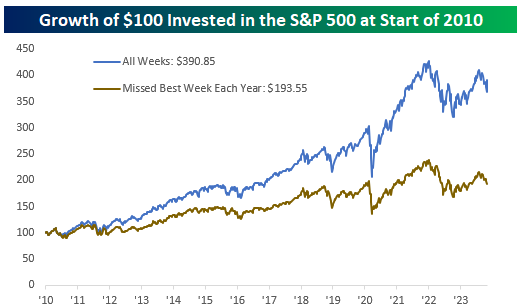When You Least Expect It
The stock market just had its best week of the year last week and bonds also performed well. I call your attention to that because it seems like it’s been a while since the markets had a good week. That sounds a bit funny when I read it back to myself because, even with all the recent volatility, broad stock market indexes like the S&P 500 and NASDAQ are up year-to-date by about 15% and 29%, respectively. That shows how mood impacts our outlook, right?
Again, I mention last week’s performance because the mood can be rather gloomy out there as we head into the end of the year. But it’s ironic and absolutely true to form for the markets that several days of good performance get strung together when most investors aren’t expecting it. It’s just Mr. Market’s way of keeping us interested.
Along these lines, my research partners at Bespoke Investment Group came out with a chart yesterday illustrating something you’ve likely heard before, that it’s time in the markets and not timing the markets that builds wealth over time.
Bespoke looked at the growth of $100 invested in the S&P 500 at the beginning of 2010 and held since, versus a hypothetical investor who missed the best week of each year because they were trading in and out, or maybe sitting on the sidelines. While both made money it was the investor who stayed the course who saw their $100 grow to $391 while the shorter-term investor’s money grew to only $194. Sometimes traders get lucky and that success keeps them going for a time, but I can attest after 20 years in this business to how hard it is for that luck to hold year after year.
Here's a chart illustrating this.

As I mentioned above, it wasn’t just stocks that did well last week. Bonds perked up a bit to get to about even for the year. This lagging performance has weighed on balanced portfolios so it’s good to see something positive coming from bonds.
Prices rose on hopes that the Fed is done raising interest rates this cycle and could even start reducing rates by next Spring. As of yesterday, investors were pricing in a 24% chance of a rate reduction in March, over 50% in May, and about 90% by July. That’s not guaranteed, of course, but bond (and stock) investors responded well to various “Fed speak” last week that seemed to indicate a “dovish” tilt in interest rate policy. This might partly be due to recession expectations coalescing around next Summer, but also because inflation has been coming back down to manageable levels. And we had news last week of the economy cooling a bit further. While you might not expect that news about our economy slowing down would be good for stocks and bonds, it is if it means the Fed stops raising interest rates. Assuming this narrative holds for a while, stock and bond prices will be volatile but will still show bursts of energy from time to time like they did last week.
What’s my point with all this? Growth, like opportunity, often appears when you least expect it, but you maximize its impact by being prepared for it. A good way to do this is to draw some clear lines in your finances between what you need to keep short-term and liquid, and what you can let ride in the markets for long-term growth to fund retirement, college costs, and so forth. Assuming you draw this distinction you should start seeing volatility as an ally instead of an enemy.
Have questions? Ask us. We can help.
- Created on .



